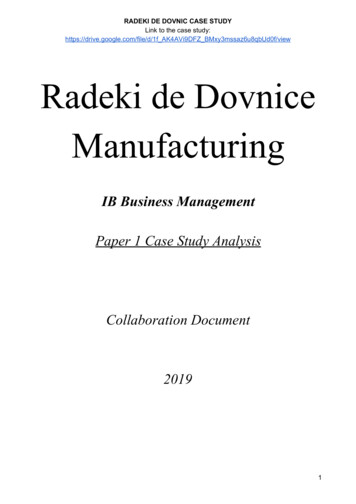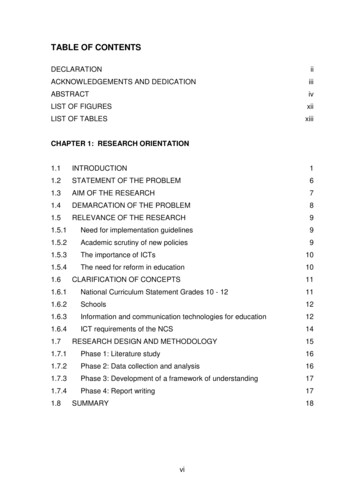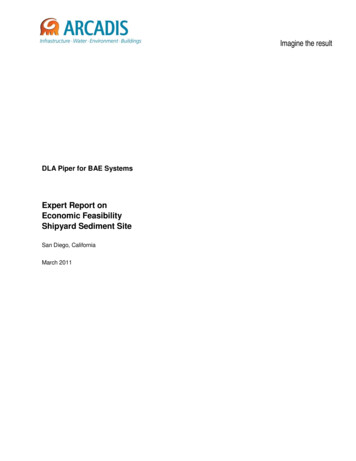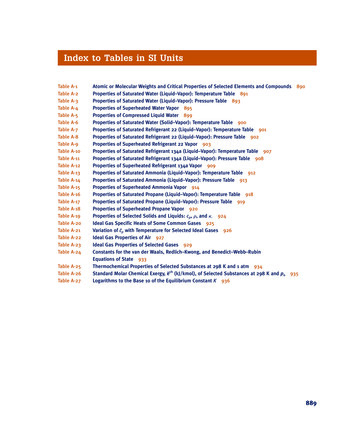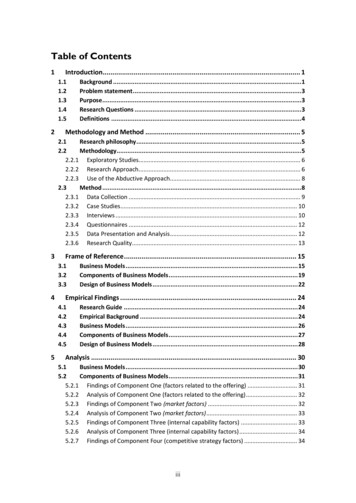
Transcription
Table of Contents1Introduction. 11.11.21.31.41.52Background . 1Problem statement . 3Purpose . 3Research Questions . 3Definitions . 4Methodology and Method . 52.1Research philosophy . 52.2Methodology. 52.2.1 Exploratory Studies. 62.2.2 Research Approach. 62.2.3 Use of the Abductive Approach. 82.3Method . 82.3.1 Data Collection . 92.3.2 Case Studies. 102.3.3 Interviews . 102.3.4 Questionnaires . 122.3.5 Data Presentation and Analysis . 122.3.6 Research Quality. 133Frame of Reference . 153.13.23.34Empirical Findings . 244.14.24.34.44.55Business Models . 15Components of Business Models . 19Design of Business Models . 22Research Guide . 24Empirical Background . 24Business Models . 26Components of Business Models . 27Design of Business Models . 28Analysis . 305.1Business Models . 305.2Components of Business Models . 315.2.1 Findings of Component One (factors related to the offering) . 315.2.2 Analysis of Component One (factors related to the offering) . 325.2.3 Findings of Component Two (market factors) . 325.2.4 Analysis of Component Two (market factors) . 335.2.5 Findings of Component Three (internal capability factors) . 335.2.6 Analysis of Component Three (internal capability factors) . 345.2.7 Findings of Component Four (competitive strategy factors) . 34iii
5.2.8 Analysis of Component Four (competitive strategy factors). 355.2.9 Findings of Component Five (economic factors) . 365.2.10Analysis of Component Five (economic factors) . 365.2.11Findings of Component Six (personal/investor factors) . 375.2.12Analysis of Component Six (personal/investor factors) . 375.3Design of Business Models . 386Conclusion . 407Discussion . 427.17.2Contributions . 42Suggestions for Further Studies . 42Reference . 43Articles . 43Books . 45Conference Papers. 46Internet Sources . 46TablesTable 2.1 Deduction, Induction and abductive: from reason to research (Saunders, Lewis andThornhill, 2012, p. 144) . 7Table 3.1 A summary of components in business models from existing authors (HolmBergquist and Ödmark, 2013) . 18Table 3.2 Components of business models (Morris, Schindehutte and Allen, 2005, p. 704) . 19Table 4.1 Conducted interviews . 25Table 4.2 Survey answers . 27AppendicesAppendix I (SWE-A) . 47Appendix II (SWE-B). 49Appendix III (SWE-C). 51Appendix IV (SWE-D) . 53Appendix V (SWE-E). 55iv
1IntroductionThis section will introduce the reader to the background of business models and biotech industry.Business models are used to illustrate the design and architecture of the value creation process of companies. One of the most important parts of a business model is how the company delivers value to its customers (Chesbrough, 2010). Chesbrough (2010) further arguesthat the business model of a company reflects the management’s theory regarding whattheir customers want, what the management team consider the value of the product or service, and how the company can create an organization to best meet those values. It istherefore important that the company communicate the value creation activities, which tellshow the enterprise will deliver value to its customers (Chesbrough, 2010).A solid business model is essential when choosing a strategy to commercialize productsand technologies (Sabatier, Mangematin and Rousselle, 2010). The design and choice ofbusiness models for biotech Small and Medium Enterprises, SMEs, are different from traditional enterprises, since SMEs in the biotech industry rarely have revenues from operating sales.1.1BackgroundAccording to Doganova and Eyquem-Renult (2009), the definition of business models canbe traced back to the dotcom era that burst in the 2000s. Morris, Schindehutte and Allen(2005) state that the interest in business models is relatively new and since the 2000s it hasinfluenced the economic world in an increasingly expansive manner.Lambert and Davidsson (2012) conclude that 69 research papers published between 1996and 2010 have the words “business model” in the title. 30 of these articles are focused one-commerce1 businesses and nine articles are focused on biotech, biomedical and/or biomedicine. The authors argue that existing research on business models have mainly beenfocused on e-commerce and that it exists further room for research in the biotech industry.When an enterprise is established it will either explicitly or implicitly choose a particularbusiness model to describe the value creation process of its business (Teece, 2010). Today,no definition has been generally accepted for the term “business model”, but according toMorris, Schindehutte and Allen (2005), key words in the 30 most popular business modelsall include “economic, operational and strategic”. Zott and Amit (2010) argue that businessmodel design is a key activity and decision for today’s enterprises. “The definition impliesthat the activities that a firm is engaging in are embedded in its business model.” (Willemstein, van der Valk and Meeus, 2007, p. 221).1E-commerce refers to business made over the Internet, via websites such as ebay.1
Lately, the business models are also argued to have become even more important thantechnology or innovation of the product (Chesbrough, 2010).It is argued that there is an absence of enough biotech enterprises focusing on findingtreatments for common diseases (Resnik 2004). The research in biotech is proven to havedirect impact on life science and health distribution, which has a direct positive impact onseveral measures of the health of populations (Resnik, 2004). Today’s research of businessmodels has mainly been focused on e-commerce (Morris et al. 2005). The authors thereforeaim to contribute to the research of business models by extending the research to focus onSMEs in the biotech industry.The most successful enterprises have typically generated revenues by implementing severaldifferent business models simultaneously to serve different types of audiences and customers in different kind of markets (Morris, Schindehutte and Allen, 2005). One major uncertainty for SMEs in the biotech industry is the duration between the initial investment andthe release of the product or service that would generate operating revenues (Sabatier,Mangematin and Rousselle, 2010). Development of new communications, new technologies and establishment of open global trading regimes have in recent years caused change inthe balance between demand and supply. This has led to the supply alternatives becomingmore transparent and enabled more variegated customers (Teece, 2010). The fast changingbusiness environment caused by fast development of technology and communications hascreated new business opportunities (Morris, Schindehutte and Allen, 2005).According to Lambert and Davidsson (2012) the business model and its components2 areimportant for ventures. By studying the business models of SMEs in the biotech industry,the authors will provide a solid foundation on business models and give suggestions to future research.2A component in a business model is argued by IBM consulting service (2005) to be modular building blockthat defines the enterprise.2
1.2Problem statementThe business model is essential for an enterprise to illustrate how it delivers value to itscustomer. In order to increase the probability of long-term success, companies need to assess their strategic options through their business model (Shafer, Smith and Linder, 2005).By examining the effect of different components in business models the authors will createa better understanding of how SMEs in the biotech industry can assess the design of theircurrent and future business model.SMEs in the biotech industry operate on speculation of future returns and rarely have operating revenues from formation. This financial obstacle is proven to greatly impact theperformance and results of their direct business activities. If the enterprise is unable to create a sustainable business and gain profits from their value proposition, the company willface financial difficulties that directly negatively impact the output (Morris, Schindehutteand Allen, 2005).Even though ventures have a great presence of market opportunities, sufficient resources,and driven entrepreneurs, their products often still seem to fail. One problem that seems tocause failures is the underlying model driving the business. There is little research publishedaddressing this question regarding business models (Morris, Schindehutte and Allen, 2005).1.3PurposeThe purpose of this thesis is to explore the design of business models for SMEs in the biotech industry.1.4Research QuestionsIt is essential to define the research questions so that these sufficiently involve and generatea sort of project consistent with what is expected from the study. The research questionsshould not only prompt a direct answer, such as yes or no. (Saunders, Lewis and Thornhill,2012).In order to accomplish the purpose of the thesis, the research question is defined as follows: What are the patterns of used components in business models for SMEs operatingin the biotech industry?Contributory questions should be created to help answering the main research question(Saunders, Lewis and Thornhill, 2012). Therefore, the authors have chosen to define a contributory research question for this thesis: What are the main motives for choosing particular components in business model/s by SMEs operating in the biotech industry?3
1.5DefinitionsBiotechThe application of science and technology to living organisms, as well as parts, productsand models thereof, to alter living or non-living materials for the production of knowledge,goods and services (OECD, 2013).Business ModelBusiness models illustrate the design and architecture of the value creation process forcompanies (Chesbrough, 2010). The concept and framework of business models will bepresented in the frame of reference.Small and Medium Enterprises, SMEFor an enterprise to be seen as a SME, it needs to have less than 250 employees and eitherhave a turnover, which not exceeds 50 M and/or a balance sheet totalling less than 43 M(The Commission Of The European Communities, 2003).Components of a Business ModelA component in a business model is argued by IBM consulting service (2005) to be a modular building block that defines the enterprise, such as customer relationship, supplier networks, or capabilities in the enterprise. Together these aim to build a complete businessmodel that illustrates how the company create value to its customers. The concept of components will be presented in the frame of reference.4
2Methodology and MethodThis section describes how the research was conducted including the research philosophy, research design, anddata collection and analysis. It will also include a verification of the credibility and give arguments for thechosen method.Saunders, Lewis and Thornhill (2012) state there is a difference between methodology andmethod: the method refers to the practical work and procedures used to obtain and analysedata. This includes for example the planned interviews, digital questionnaires, and interpretation and analyse of data. The term methodology refers to the theory behind the researchand how it should be conducted.2.1Research philosophySaunders, Lewis and Thornhill (2012) argue that we make assumptions in all stages of ourresearch. The assumptions shape how researchers understand research questions, themethods that are chosen and how the findings are interpreted. Researchers must be awareof the subjective and socially constructed meaning, which is expressed about the researchtopic. The adopted research approach will reinforce the research strategy, the method andthe outcome of the research (Crotty, 1998; Saunders, Lewis and Thornhill, 2012).In this research the authors have chosen an interpretive approach for its strength in understanding social features, such as emotions and values.2.2MethodologySaunders, Lewis and Thornhill (2012) argue that the researchers make assumptions in allstages of the research. The assumptions shape how the researcher understands the researchquestions, the method, and how the findings are interpreted and analysed. Researchersmust be aware of the subjective and socially constructed meaning expressed regarding theresearch topic. The adopted research approach will reinforce the research strategy, themethod and the outcome of the research (Crotty, 1998; Saunders, Lewis and Thornhill,2012).In every research it is pertinent that the researcher gathers truthful and valid empirical data(Saunders, Lewis and Thornhill, 2012). If the researchers ask questions that cannot be applied to the study, the researchers will not be able to use the answers for the analysis andconclusion. Because researchers assume and interpret the data, they have to focus on a philosophy, which will prevent them from subjectively interpret the answers (Saunders, Lewisand Thornhill, 2012).The authors have previously discussed that there is little research conducted in the field ofbusiness models for SMEs operating in the biotech industry and that existing researchtends to be descriptive rather then exploratory. The differences between descriptive re-5
search and exploratory research are that descriptive research can be an extension of exploratory research, and that the data often are collected through quantitative methods (Saunders, Lewis and Thornhill, 2012).2.2.1Exploratory StudiesExploratory studies are mainly carried out when there is little or none earlier research to refer to (Saunders, Lewis and Thornhill, 2012). Because research of business models in thebiotech industry is a rare field of study, exploratory approach is suggested.Exploratory, descriptive and explanatory are three different approaches of how to conducta research when choosing a research approach. Saunders, Lewis and Thornhill (2012) describe the exploratory research method to be a valuable mean to ask open questions in order to find patterns and gain in-depth understanding about a topic. It is especially useful ifthe researcher aims to illuminate the understanding of a problem. One of the benefits withexploratory research is that it is flexible and allows for change in the light of new data(Saunders, Lewis and Thornhill, 2012).This research was designed to explore existing business models through several case studies. Therefore this research was conducted in a qualitative manner and the data was collected from questions and discussions via emails, phone calls and interviews as well as throughliterature search.The authors chose to conduct a research, which enabled in-depth understanding of thespecific cases and also due to its ability to manage time and geographical constraints. Thiswas to fully understand the design of business models in SMEs in the biotech industry.This would argue to use and emphasise a qualitative approach rather than quantitative approach due to the nature of this research.A quantitative approach would have allowed the authors to collect answers through for example a digital survey including a large sample. On the other hand, the qualitative methodand approach allowed the authors to do an in-depth exploration through interviews, whichis also argued by Gummesson (2000) to be a useful tool for business and management research.2.2.2Research ApproachSaunders, Lewis and Thornhill (2012) state that when conducting a research, it is importantto choose a research approach that fits the purpose of the research topic and enables theresearcher to fully gain from the information gathered. Saunders, Lewis and Thornhill(2012) present three approaches from which to decide on the design of the scientific research: DeductionInductionAbduction6
According to Saunders, Lewis and Thornhill (2012), it is important to realize the differences between these three approaches when deciding on which to adopt for the research.Table 2.1 from Saunders, Lewis and Thornhill (2012) shows the differences between these.All approaches help to determine the starting point for the research and the proceedingwork.The choice of research approach is argued to enable a more informed decision regardingthe research design. The choice is derived from the configuration, which involves whatkind of evidence is gathered, and where and how it is interpreted in order to provide unbiased answers to the initial research questions (Saunders, Lewis and Thornhill, 2012).Table 2.1 Deduction, Induction and abductive: from reason to research (Saunders, Lewis and Thornhill, 2012,p. 144)DeductionInductionAbductionLogicIn a deductive inference, when the premises are true, the conclusion must also be trueIn an inductive inference,known premises are usedto generate untested conclusionsIn an abduction inference,known premises are used togenerate testable conclusions.GeneralizabilityGeneralising from thegeneral to the specificGeneralising from thespecific to the generalUse of dataData collection is usedto evaluate propositionsor hypothesis related toan existing theoryData collection is used toexplore a phenomenon,identify themes and patterns and create a conceptual frameworkTheoryTheory falsification orverificationTheory generalisation andbuildingGeneralising from the interactions between the specific andthe generalData collection is used to explore a phenomenon, identifythemes and patterns, locatethese in a conceptual framework and test this throughsubsequent data collectionand so forthTheory generation or modification incorporating existingtheory where appropriate, tobuild new theory or modifyingexisting theorySince the purpose of this research was to explore the design of business models, the authors chose to use the abductive approach.The abductive research approach was chosen from the context of enterprises in the biotechindustry, since it enabled the authors to move between theory and findings in order to create reliable conclusions and be able to analyse the findings (Saunders, Lewis and Thornhill,2012). According to Saunders, Lewis and Thornhill (2012) abductive approach is helpfulwhen researchers are looking for new insights through describing what is happening, askingquestions and comparing empirical data with existing theories. Saunders, Lewis and Thornhill (2012) also emphasise the advantage of the exploratory research’s flexibility. However,this require the researchers to be open for change as new insights can appear, which mightchange the focus of the research itself.7
2.2.3Use of the Abductive ApproachSaunders, Lewis and Thornhill (2012) describe the abductive approach to move back andforth between theory and empirical findings, combining the deductive and inductive approach. The research begins from a surprising observation and then working towards aplausible theory of how this could have occurred (Ketokivi and Mantere, 2010).In this study, the collected data was combined and integrated in an overall conceptualframework that was compared with existing theory.After the initial data was obtained, the authors decided to proceed and start researchingabout business models of other SMEs and find existing theoretical data to validate the findings. This would give a brief overview of the research topic to fully gather valid data, whichwould be useful for the research.The qualitative data was obtained from participating companies through interviews with amember of the management team. Every interviewee had relevant qualifications and expertknowledge of the subject to answer the research questions in this study. Before conductingthe interviews, the authors made sure that the contact was positioned in the managementteam and possessed knowledge regarding the business strategy and business model.The qualitative method was preferred since these interviews and dialogs mattered in understanding the design of their business models. This also enabled discussions and clarificationof critical points and grey areas as paramount in contrast to the already gathered qualitativedata. Due to the nature of this study, the qualitative research approach helped fulfilling thepurpose of this thesis since it focuses on behaviours, feelings and human emotions, andnot on presenting any numerical data (Körner, Ek and Berg, 1984).2.3MethodThe method is the description of how the researchers work to gather and analyse the datafor the thesis. The method assists in establishing a solid foundation for how the researchersexplore the design of business models for SMEs operating in the biotech industry.The authors focus on SMEs in the biotech industry because of the argued financial and operational obstacles that these companies face. This was stated in an interview (see Table4.1) conducted with SWE-A2. After the interview, the authors conducted a pre-study onthe topic, were further support was found.In the interview with SWE-A2, “33 Listan” (33 Listan, 2013) was introduced to the authors. The “33 Listan” presents Sweden’s 33 most promising technology companies. The“33 Listan” of 2012 and 2013 included SMEs operating in the biotech industry. The authors then chose to approach the companies that were operating in the biotech industry.All the companies that the authors contacted responded and showed interest to participatein this study.SWE-B, which was included in this research, was not found through the “33 Listan”. Thatcompany was introduced to the authors during the interview with SWE-A1. That SME was8
contacted because they fitted well in the research profile as a SME operating in the biotechindustry. By including SWE-B, the authors believed that the company could bring some insights to the design of business models in the biotech industry.2.3.1Data CollectionData can be either primary or secondary. The researchers themselves collect primary data forinstance trough questionnaires or interviews. Secondary data on the other hand, is collectedfrom previous researchers (Eriksson, 2011). Using existing data, i.e. secondary data, saves bothmoney and time. However, the disadvantages are that it is not designed for the specific research area (Zikmund, 2000). Therefore, it is important to verify the collected secondary dataand carefully examine it before using it (Eriksson, 2011).In this study, data was collected from primary and secondary sources. According to Zikmund (2000), secondary data enables the researchers to build the work on past research.2.3.1.1Primary DataPrimary data was collected through interviews and a digital questionnaire with the participating companies, which will be presented later in this section. These were considered themain primary source since it was used to obtain the specific data with the purpose of answering the research questions. Saunders, Lewis and Thornhill (2012) state that interviewsand questionnaires help gathering reliable data, relevant to the research questions.2.3.1.2Secondary DataSecondary data regarding business models and their components, cover existing research,and was collected through Jönköping University library, through literature, handbooks andscientific journals. All secondary data was reviewed by looking at well-known and influential scholars as well as highly citied researchers so the authors could establish a good understanding of business models and its components. For the online literature research, the authors primarily used Google Scholar and Scopus.Frequent key words used in the online information search were the following in differentcombinations, singular and plural and also different spellings due to the differences inAmerican and British English: Business model Biomedicine Development intensive SME Dynamic Innovation Value creation System Entrepreneurship Business architecture E-business Value added sequence Strategy Success factor Biotech ComponentThe authors aimed to guide the reader through the section and create an understanding oftheories to from a solid foundation. This was done by first introducing the business modeldefinitions, and then guiding the reader through the available research in business models,its components, and the design.9
2.3.2Case StudiesCase studies focus on understanding the dynamics within its context and can involve singleor multiple cases, as well as numerous levels of analysis. Eisenhardt (1989) argue that researchers should use more than one single case, where “between four and ten cases usuallyworks well” (p.545). By using more than one case, the researchers enable theory creationand the empirical findings are likely to be more convincing (Eisenhardt, 1989; Yin, 2003).The data collection typically combines methods such as archives, interviews, questionnairesand observations, where the evidence may be both qualitative and quantitative. The casescan be
According to Doganova and Eyquem-Renult (2009), the definition of business models can be traced back to the dotcom era that burst in the 2000s. Morris, Schindehutte and Allen (2005) state that the interest in business models is relatively new and since the 2000s it has influenced the economic world in an increasingly expansive manner.

